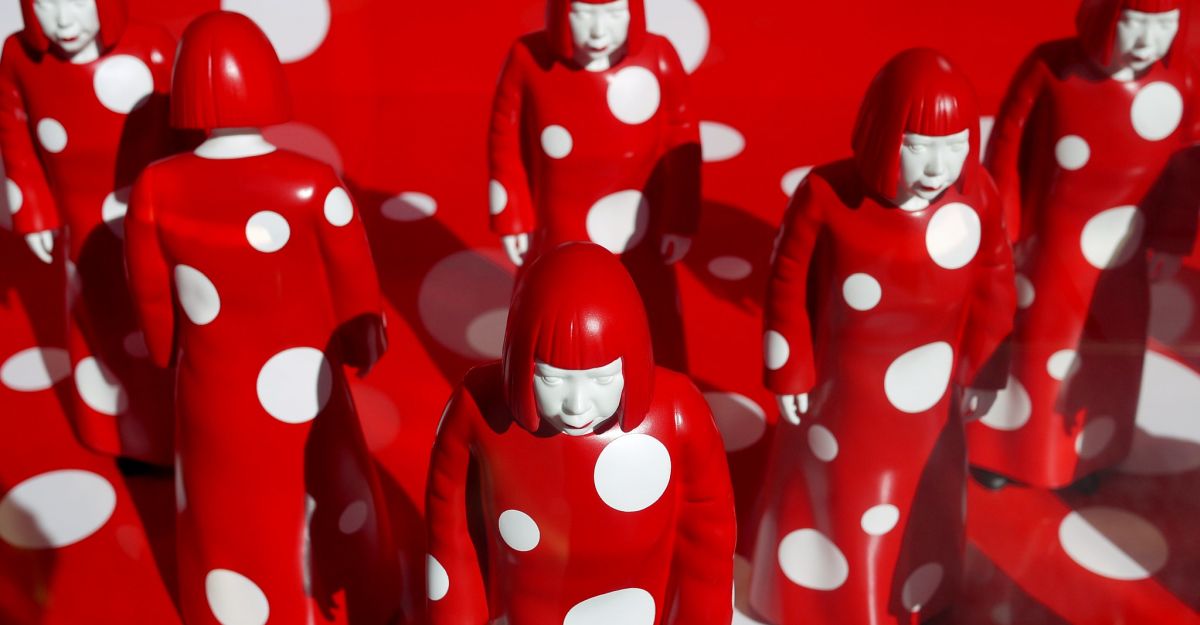In 2012, Yayoi Kusama’s face, form and tentacles beset Louis Vuitton stores all over the world. A giant Kusama doll appeared above the clock at Selfridges. and armies of her likeness appeared in windows in London and throughout Europe, alongside handbags and scarfs overwhelmed with polka dots and protrusions. Since then, Kusama has collaborated again with Vuitton (including a revisiting of the 2012 collaboration in 2023), to create products themed by her image and work.
While these projects have expanded her popular and global success, Kusama’s work continues to be either overlooked or criticised by art commentators and scholars who characterise it as either simple and crass — primarily a commercial (but not artistic) success — or the private expression of mental illness made public and popular. However, this dismissal overlooks the point of the commodification of her work. Captured in Kusama’s insistent commercial and personal branding is a transgressive message revealed in the surface of luxury goods and blockbuster exhibitions.
The NGV has just announced a new major exhibition of Kusama’s work to open in December, scheduled to be a summer art ‘blockbuster’. As the somewhat disparaging term suggests, blockbuster exhibitions are generally not positively regarded in art and curatorial scholarship. The elitist criticism of blockbusters tends to be that they are “predictable and shallow,” therefore antithetical to serious art. Commentators routinely vacillate between declaring them “over” and a necessary evil to appease the “masses” whilst funding the “real” work of museums and galleries.
While there have been shifts in recent years, blockbuster shows still typically centre on the work of dead white male artists, and so the very fact that Kusama’s shows have come to be some of the most commercially successful blockbusters worldwide is, in itself, a unique phenomenon.
Kusama’s project, and the work she produces, lends itself to the blockbuster format. Her work is aesthetically pleasing and enjoyable, even while underpinned with ideas that remain conceptually challenging. Her work invites interaction. She creates worlds and universes of repetition designed to unsettle and overwhelm in an utterly satisfying way. She designs objects and experiences that are perfect for Instagram, and not at all by accident.
Kusama has never shied away from partnerships with high fashion brands, like her repeated collaborations with Louis Vuitton, as well as more surprising associations. She once advertised dildos in a single-issue magazine that accompanied her happening Grand Orgy… in 1969, while in 2012 she designed a limited-edition Champagne bottle for Veuve Clicquot. This strategic commercial collaboration and branding has been used as ammunition for the continued dismissal of Kusama, years after she was repeatedly ignored and dismissed by the New York art scene, whilst its most successful artists refused to acknowledge her clear influence on them. I personally chose to pursue publication for my research on Kusama in the scholarly art journal third text because no one had ever published on her work there before, which — given that she is among the most well-known and commercially successful living artists in the world —reflects this dismissal. In 2023, she was the world’s most commercially successful contemporary artist, yet there is very little written about her work that does not either reduce it to an expression of mental illness, or discuss it as an example of a kind of liberal feminist project that presents a woman’s final achievement as one of individual commercial success.
While Kusama’s biography features a wealthy upbringing (albeit in Japan through World War II), she pursued fame and success in a way that has made many western art critics uncomfortable with her hustle in a manner that can only be described as classist. Before moving to the United States, she wrote to Georgia O’Keefe, and declared — amongst other things — her ambition to become “an international avant-garde artist”. However, this reflects an ambition to effectively obscure herself amongst the material of her work. She expresses her “fears” through very literal representations of psychoanalytic symbolic order, and later, through the repetition of her own image, disappearing into the Kusama brand while establishing it.
Alongside the classist critique of Kusama lie the multiple spectres of her marginalisation and have contributed to the dismissal of her work on the basis of its commercialism. This is most clearly evidenced when the reception of Kusama’s ventures is compared to that of Andy Warhol, who is generally understood to have been a substantial contributor to the development of twentieth century art, including in the industrialisation of art production in The Factory.
It can only be imagined (seeing as it has not been widely documented or discussed) that the race- and gender-based barriers, exclusions and indignities Kusama faced when she arrived in New York in the late 1950s must have been substantial. The relationship between racialisation and the dismissal of her work is further complicated by her own expressions of racism, most notably the anti-Black passages in her autobiography (Infinity Net, 2012) for which she has since apologised (although this is not the only example in her writing archive).
In my scholarly work on Kusama, I have argued that her entire art practice can be understood as a project designed to be a lifelong, lingering performative suicide, using the Japanese model of Seppuku. The practice of self-erasure and the literalisation of this performance is articulated in her work again and again. We can see this from her first novel, Manhattan Suicide Addict, to the assertion that her use of dots are designed to return the wearer “to the infinite universe.”
This “suicide” has the potential to be misunderstood as akin to what we understand by suicide in western culture. As a result, it is added to the list of symptoms that theorists of psychoanalysis pick over — and which Kusama often provides contradictory reports for, possibly to further obscure any possibility of defining her. At the same time, descriptions of Kusama’s work use her language — obliteration, suicide, return to the universe — without appearing to register what her vocabulary implies. Kusama designs “obliterating” rooms, and no one is at all concerned that the obliteration is an insistence on the reimagining of form, and destruction of the world as we ordinarily understand it.
Kusuma’s suicide is an insistent, repetitive destruction of the illusion of individual selfhood. The construction of a sense of self as separate from other beings is something we all practice, and which provides us with a sense of autonomy and agency. Kusama’s work challenges that autonomy by inviting us into the ways she loses herself. Kusama literalises the self-loss inherent in communication, in eroticism, and in death through her work, and we all know it’s such a relief not to have to be yourself for a minute. Kusama’s brand is that feeling for a lifetime. Little wonder people will line up for hours to lose themselves in the repetition of infinity mirror rooms during a designated five-minute slot.
Self-loss as a way of feeling less separate from the world: this is a destruction of cohesive selfhood, with Kusama’s as a performance of artistic psychosis leading the way, and so the point is, in this sense, in plain sight.
Kusama’s series of polka dot accumulations are referred to as “obliterations” and the premise of the polka dots themselves is to obscure the static or reliable form of bodies and objects covered in them. To commodify obliteration is to sell the aesthetic destruction of the luxury goods covered by dots, making them, and yourself, symbolically indistinguishable from the matter of the universe.
Kusama, as a symbol, and as a project of one visionary ninety-five-year-old Japanese woman who has been performing suicide through art practice since the age of ten, is capitalising on our collective fascination with the desire to return to the infinite, and to cease the obligation to the pretence of individuality. It is darkly comical and deeply pleasing that Kusama’s work proliferates across luxury goods, the polka dots implying the destruction of the handbag’s form. Buying a chance to remove yourself, and your bag, from the labour and drudgery of existence. Return to the infinite universe. Love forever.
Image: Flickr



